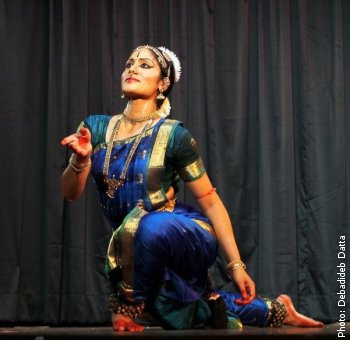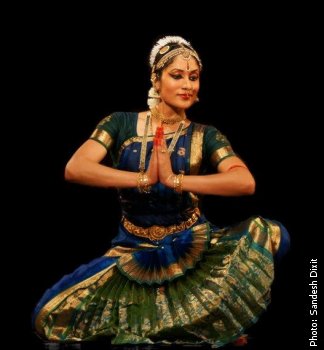
|   |

|   |
Janaki Rangarajan's impressive Bharatanatyam recital - Dr. Sunil Kothari e-mail: sunilkothari1933@gmail.com July 6, 2012 On 29th June 2012 under the Horizon series, Indian Council for Cultural Relations (ICCR) presented Janaki Rangarajan, a disciple of Dr. Padma Subrahmanyam, in an impressive Bharatanatyam recital. Dividing her time between Washington, USA and Chennai, Janaki has in recent years drawn attention for her Bharatanatyam performances, for her brilliance and choice of items, which keep her audiences engaged in her presentation.  Last year in Chennai at Brahma Gana Sabha, she had the audience eating out of her hands. Dancing before a critical Chennai audience, she had won warm applause and praise for her presentation to live music. Later on, we met again on a flight to Bhubaneswar as she was to perform at a dance festival to be held at Cuttack. Running an institution Nritya Niketan in Alexandria, Washington DC, Janaki makes it a point to visit Chennai for the season and also gives numerous performances in other cities in India. I knew her only four years ago, and did not know that she had studied under Dr. Padma Subrahmanyam and her earlier training was under Madhavi Chandrasekhar of Tiruchi, nor did I recollect seeing her as a trouper in Padma's Nrithyodaya dance company, where from 1993 till 2001, she not only participated in dance dramas choreographed by Padma, but also taught at Nrithyodaya. I only knew her as an Indian Diaspora dancer settled in USA. Besides dancing, she has a Ph. D in molecular genetics and has many other high academic qualifications. I came to learn all that recently, as by temperament she is very modest, which indeed is a very winning quality. She opened her recital with a brief introduction presenting a Kriti by Muthuswami Dikshitar in Kumudkriya raga and Rupaka tala. She covered the stage and struck a pose of Lord Shiva with clear lines and admirable balance. Her stage presence is arresting. With tall figure, long arms and mobile visage, which registered bhavas without any exaggeration, she at once succeeded in drawing attention of the audience. The recorded music was well balanced with Hari Prasad's melodious voice. The Sanskrit kriti had several upamas, similes, extolling Lord Shiva's personality, divine attributes, playing upon a damaru and with Ganga flowing from his hair. As Ardhanarishwara, combining both male and female bodies, Janaki enacted those two personas with consummate artistry. The graceful lasya, feminine, sculpturesque pose and vigorous one for Lord Shiva were etched clearly. The subtle attami, movements of the sundari griva, neck and netrabhinaya, expressions through eyes, enhanced feeling of involvement and devotion. The various rituals like abhisheka, drawing with ashes tripunda, marks on shoulders and so on, on the Shiva linga were done with imagination, describing the alankaras, ornaments, earrings of serpents, Nagendramanibhushanaya, aneka veda, possessing knowledge of Vedas, sacred scriptures et al were enacted with artistry, eschewing Padma's karana oriented style with clean straight lines of Bharatanatyam, at times employing katichhina, lina, and other karanas, the texture of the amalgamated form looked attractive.  Taking up Lalgudi's Charukeshi varnam in adi tala, explaining the content in brief incorporating sancharis of two episodes, viz., Satyabhama and Rukmini's devotion to Krishna, Satyabhama with tulabaharam, balancing Krishna with all her wealth and Rukmini's placing tulsi leaf and emphasizing devotion which wins the Lord; childhood friend Sudama's visit to Dwaraka, his plight, relishing the puffed rice, and when Sudama returned empty handed, he saw the palace in place of his humble hut and wife bedecked with ornaments, children playing happily - both episodes were enacted with sophistication and brevity. Her entreaties to Krishna begging him not to ignore her, her infatuation listening to Krishna's flute, its impact on birds and animals and enchantment, Krishna's mock indifference and so on were projected with discreet abhinaya, minus exaggeration or over dramatization. The teermanams had lyrical quality, encapsulating melody of Krishna's flute. The tattamutti adavus were executed with finesse and firmness. There was nothing sloppy. Minus one or two poses, all sculpture, in which nayika holds her arms above her head and lifts her face towards nayaka, the others were well chosen. She warmed up towards end of the varnam with great animation, elaborating upon the word Manamohana, who enchants one's mind, and when Krishna does not relent, she blames her fate, and wipes her tears, not once losing her faith in her Lord. Hari Prasad's evocative singing added to the charm of the varnam. Subbarama's padam in Husseini dealt with the nayika watching the Lord dallying with other woman on the banks of a river. When she had gone to fetch water, she had seen him with the other woman, enticing him with all her charms - even when the nayika was around, the Lord did not notice her. Whatever happened to the lovely time she and her Lord had spent together - he placing flowers on her hair, embracing her, the delicate love play between them - he forgot all that and fell for that other woman? The abhinaya was becoming of an uttama nayika and was full of restraint. She concluded the programme with a Tillana in Paras raga, incorporating praise of Goddess Abhirami. Tillana had vibrancy and exquisite diagonal arm movements, leg extensions and sparkle. All this she managed within one hour and left the audience wanting to see more. The shanti mantra with sarve janaha sukhino bhavantu, created an ambience of vishranti, peace. In spite of the unbearable heat, and air-condition not functioning, one marveled at Janaki's performing with controlled breathing and admirable stamina. After a taxing varnam, with brief pause, she could explain the next number without showing marks of stress, spoke of her professionalism and sense of programming. I have no doubt that Janaki will go places with her talent and art of presentation. Exposure to audiences abroad, participating in International Festivals like Jacob's Pillow, Festival of India, World's Art, Music and Dance Festival and regular participation during Chennai's season have helped her build her reputation on merit. Here is a dancer worth watching.  Dr. Sunil Kothari is a dance historian, scholar, author and a renowned dance critic. He is Vice President of World Dance Alliance Asia Pacific India chapter, based in New Delhi. He is honored by the President of India with Padma Shri, Sangeet Natak Akademi award and Senior Critic Award from Dance Critics Association, NYC. He is a regular contributor to www.narthaki.com, the roving critic for monthly magazine Sruti and is a contributing editor of Nartanam for the past 11 years. Post your comments Pl provide your name and email id along with your comment. All appropriate comments posted with name and email id in the blog will also be featured in the site. |